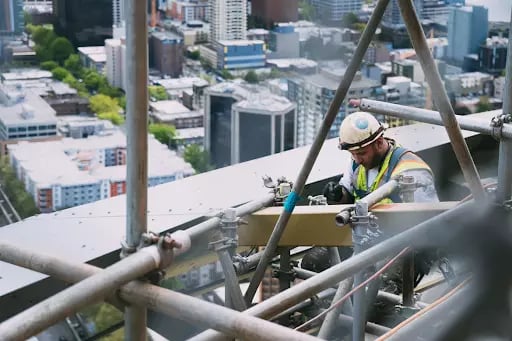In 2005, the Work at Height Regulations (2005) were introduced to ensure the safety of those who work at potentially dangerous heights and they are still in place today. What does all this legal jargon actually mean for duty holders and employers in industry sectors that work at height?
It can be hard to decipher from the government legislation what is actually required of you in order to comply with these regulations - we’re here to break things down for you in an accessible and informative way below.
The Health and Safety Executive (HSE) defines working at height as “work in any place where, if precautions were not taken, a person could fall a distance liable to cause personal injury”. This includes work undertaken above ground or floor level, or work where falling from an edge or from ground level into an opening in a floor, a fragile surface, or hole in the ground is possible. If you’d like to hone in on more detail as to how working at height is defined by the HSE, take a look at our blog on this subject.
Download your free copy of our ‘No-Nonsense Guide to the Working at Height Regulations (2005)’ to discover what this legislation means for you and what your next steps should be.
Under the Health and Safety at Work etc. Act (1974), it is legally an employer’s duty to ensure a safe working environment for their staff so far as is “reasonably practicable” - the Working at Height Regulations (2005) are included under this legislation. However, this also applies to those who are self-employed or those who manage the work of others, such as building contractors or facility managers.
The core responsibilities of the duty holder outlined in the regulations can be broken down into the following practices:
Work at height should be planned, supervised, and carried out by competent people. But what exactly does competent mean? The term is definitely subjective, but in the case of the law and the Work at Height Regulations, competency is defined as being based on the individual having the necessary “skills, knowledge, and experience” to undertake the work.
In the year 2020/21, the HSE reported that there were 35 fatal injuries in the UK that were a result of falls from a height - which accounts for 25% of all annual worker deaths. It’s important to take this legislation seriously as not only does this protect your employees’ wellbeing and safety, but it’s also in your best interests as an employer to comply. You (the dutyholder) will be held liable if an accident was to occur and you were complacent in following the legislation.
Such repercussions can be prevented by following the HSE’s advice and guidance for working at height - avoid, prevent, and minimise.

Risks related to working at height must be considered and managed so far as is reasonably practicable in order to keep your employees safe when working at height.
The Work at Height Regulations (2005) can be easy to navigate if you are properly educated on how to stay compliant - allowing you to make informed judgements on how to control the risks of working at height.
Get our expert knowledge delivered straight to your inbox, and keep up-to-date with the latest goings on in your industry.
Falls from a height continue to be the most common kind of fatal injury in the workplace for the 4th year running - with 171 fatal injuries from 2016-2021 being due to falls from a height. You may be ...
In 2005, the Work at Height Regulations (2005) were introduced to ensure the safety of those who work at potentially dangerous heights and they are still in place today. What does all this legal jargo...
According to HSE, you should be taking vital steps to protect your team when working at height. One way to minimise the likelihood of an accident is through the use of a Fall Arrest System.